Here’s some great tips on how to clean and care for a custom wig!
Although we use a custom Santa wig to demonstrate, the tips and techniques are the same for nearly any custom wig or facial hair we create.
Cleaning Adhesive Off Wig Lace
The lace front edge of your custom wig or beard of the can get pretty dirty after wearing. Liquid adhesive can build up an unsightly and damaging residue if not cleaned often. This step should be performed as regular maintenance, after each wearing.
Not maintaining a custom wig or facial properly can damage it, and damage is difficult – and expensive – to repair.
The lace edge is the most fragile areas of the wig or facial hair – not to mention the most visible. Even a small amount of leftover glue or makeup can be very visible.
You’ll need:
- 90% Isopropyl Alcohol
- Washcloth, a very soft-bristled toothbrush or a felt shoe-polish dauber
- Shallow dish or tray
-
Soak the washcloth in alcohol or dip the toothbrush into it until soaked OR fill the shallow dish with a little alcohol
-
Hold the washcloth or dauber on the inside of the lace wherever residue from glue and makeup has built up. Keep it pressed there for a few seconds
-
With your cloth (or the toothbrush) gently wipe off the glue, using care not to abrade the lace. You want to just barely loosen the glue, not scrub it off.
- You can also gently dip the edge of the lace into the shallow dish of alcohol, letting it sit for a moment. Then use the soft cloth, dauber or toothbrush to gently displace the glue.
Please note that it is always a good idea to check with the manufacturer’s instructions for the adhesive you are using – they will provide more specific information on using and removing their product from both skin and lace.
Here’s a video on removing adhesives from wig lace
Don’t:
- Use anything besides alcohol! Acetone and other strong cleaners can ruin the lace and hair
- Let the wig sit in the alcohol for more than a few seconds at a time. Several brief dips are better than a longer soak
- Use any oil-based products to clean the wig
- Soak the entire piece
We’re proud to offer professional wig and beard styling tools, care and maintenance supplies and a selection of wig and beard tapes.
These products are also available for purchase at any time in our store – click the buttons below to learn more about the items or order.
Your Santa order form includes the option to add these tools and supplies to your order at a discount.
How to wash a custom wig or facial hair
You’ll need:
- A canvas head form of the correct size
- A wide-toothed comb
- Twill tape or similar
- Shampoo and conditioner
- A sink and warm water
First off, remove any hairpins, bobby pins or other items. The wig or beard should be completely loose when you’re done.
-
Block the wig onto a head form.
If you’re not familiar with this process, it’s when you use a bit of twill tape or similar tightly-woven ribbon to pin down the front of the lace to the head form. This helps take the pressure off the lace (it needs to be perfect to disappear into your skin correctly!)
See the video below for a demonstration of lace front blocking.
1.Using a wide-toothed comb, comb the wig to remove knots and matting.
2.Remove the wig from the head form (put the twill tape and pins aside – you’ll need them later)
3. In the sink, hold the wig under the water until it is wet but not soaked. Take care not to plop it in the sink or soak it, as human hair wigs don’t take well to that.
4. With the wig in one hand, put a dollop of shampoo in your other – you just need a dime-sized blop. You can use any shampoo that’s suitable for human hair on your wig or beard.
5. Still holding the wig, use your other hand to stroke the shampoo through. Don’t ruffle, scrub or go against the grain of the hair!
6. Once you’ve worked the shampoo through, let it sit for just a moment, then rinse the wig. (As a rule of thumb, if you think it’s rinsed out, rinse it again for good measure).
You can repeat step six with conditioner, especially if you’re about to put the wig away for a long stretch
Blot the wig with a towel – you can fold it over inside and sandwich it lightly between your hands to get water out, but never press too hard! Don’t ring or squeeze it either – you’ll risk damaging the wig! The towel should absorb most of the water from the wig hair.
Once most of the water has been absorbed into the towel, return the wig to the canvas head and re-block the front of it as we did in step one. Be very gentle at this stage – the wig and lace are vulnerable when damp and can end up stretched or damaged.
Gently detangle the wig with the comb you used earlier. Don’t work the wig too hard in this step! Just enough to get the tangles out.
It’s very important to have the wig blocked. That ensures the wig will stay put but also that the weight of the wet hair and the force (gentle though it is) of the combing do not damage the lace.
Don’t forget to have the wig on a properly sized head form! One that’s too small will create wrinkles and one that’s too large will stretch it out of shape.
Let the wig dry completely.
Don’t:
- Soak the wig or beard in water – human hair swells when wet and the knots can work loose
- Work shampoo against the grain of the hair
- Squeeze or ring water out of the wig
- Use an improperly sized head form – it can ruin the wig
- Forget to block – If you miss this critical step you can risk tearing holes in the front lace, inducing costly repairs.
As always, feel free to contact us with any questions or clarifications you need from this article.
If you’d prefer not to wash and re-style your wig, you can take advantage of our cleaning and maintenance service.
Santa Care Cleaning & Maintenance Service
Our annual Santa Care Cleaning and Maintenance Service is available each year for our Santa and Mrs. Claus clients. With this special service, you can send your pieces to us after the holiday season for a full cleaning and restyling, as well as repair and maintenance for standard wear and tear.

How to store your custom wig or facial hair
The best way to store your wig or facial hair is on a canvas head or chin block. These sturdy blocks help your piece keep it’s tailored shape and they help maintain the style.
If you don’t have a canvas block, you can use a styrofoam head. The important thing is to keep your wig or beard upright and supported.
Your piece should be kept in a secure location away from excessive light, moisture or temperature fluctuations. Keep the piece away from pollutants like smoke or grease – these will discolor the hair.
Ideally, your wig or facial hair will be stored in a cupboard or closet but a large box or wig carrier will also protect it from the environment.
Tips for maintaining the style of your wig or facial hair
Keeping your pieces on a head or chin makes it easier to keep the style intact. If your wig or beard hangs loosely or has long curls, use a large hair net to cradle and support the hair during storage. This keeps gravity from slowly pulling the curl or wave right out of your piece!
If your piece is starting to droop, carefully block it onto a head or chin block. Then place rollers in the lank strands. Mist the rolled strands very lightly with water and let them dry completely. This will help reset and restore the curl or wave without a full reset.
For wigs with long, trailing curls, use duckbill clips to keep the curl rolled up and tidy during storage.
Be very stingy with styling products, especially hairspray. It might be tempting to coat your wig or beard with hairspray. But doing so won’t really keep your style in place, especially in humid or damp environments. What’s worse, moisture from the room or perspiration will cause the hairspray to ‘reactivate’. Then, that same moisture causes the hairstyle to start drooping. When the piece finally dries, the hairspray re-dries, too – and is likely to set your style in the ‘fallen’ state.
Take a photo of your wig or facial hair the first time you wear it. Use this photo to check the style regularly. A hairstyle can slowly morph and you might not even realize the style is changing until things have shifted dramatically. A quick check against your first photo can help you keep the style consistent.



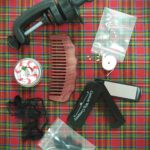
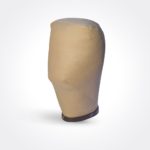
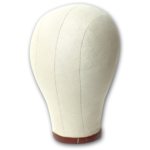
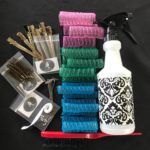

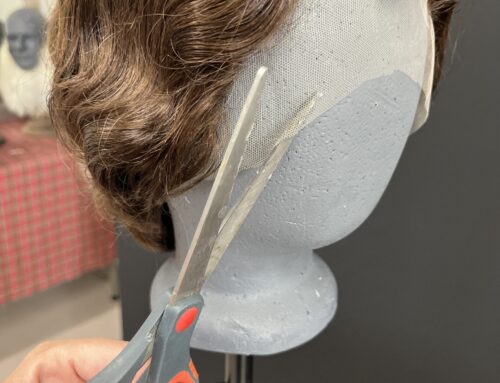

I have a glass head form I use in a deep sink to shampoo my wigs. I don’t have any problems with tangles and it makes rinsing easy.
Shampooing on a head is always an option, though we tend to think it works better with wigs that don’t have a lace front. Sometimes when a lace front wig is blocked onto a head and then shampooed, the weight of the wet hair can pull against the lace and cause rips or distortions, even with the careful reinforcing of the blocking tape.